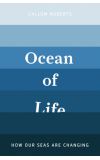
03 Dec 2012 23:59:55
Earth's oceans are immense. They cover 360 million square kilometres and fill a volume of 1.3 billion cubic kilometres. Such dimensions are impossible to comprehend and blind us to the vulnerability of the seas that are our planet's lifeblood. Thus UK marine biologist Callum Roberts suggests in Ocean of Life (Allen Lane £25) that we think of them in a more telling manner. View the oceans from the scale of the planet, not from a human perspective, he argues. Then the oceans appear to form "a layer only as thick as the skin of an apple". And that skin is getting frayed, battered and damaged. Over-fishing, acidification, and rising temperatures are playing havoc with Earth's seas. And not just the water. The seabed, "with its complex habitats rich in coral, sponge, seafan and seaweed", have been dredged over and converted into "endless monotonous expanses of shifting gravel, sand and mud," he adds.
It is a grim story and in another writer's hands, Ocean of Life might have ended up as a mordant tale of ecological despair. Roberts, to his credit, gives us hope and provides a prescription for political and public action, right down to our choices of seafood in supermarkets.
In Beyond the Blue Horizon (Bloomsbury £20), Brian Fagan – a California-based anthropologist and experienced sailor – also focuses on the seas but in this case presents us with a vivid picture of the nautical experiences endured by the first sailors who, in tiny canoes and rafts, made astonishing ocean-wide journeys more than 50,000 years ago and who laid the planet open to human conquest. Those journeys changed the course of history and Fagan gives rigour and depth to this overlooked chapter of our history.
Equally impressive is Mark Pagel's Wired for Culture (Allen Lane £25), a detailed, highly readable analysis of the evolutionary origins of human society. As Pagel – head of Reading University's evolution laboratory – points out, men and women do not cooperate mindlessly with one another as other social creatures do, such as ants and termites. We sometimes act with considerable individuality but most of the time we choose to suborn our independence for the overall good of society. In this way, we act like a venture capitalist who is trying to invest money, says Pagel. We seek out the best individuals with whom to form alliances and try to establish sound reputations so the best will seek us out. Thus we give up seats in trains, give to charity and even risk our lives to save animals – to enhance our reputations so others will cooperate with us. It's an intriguing analysis.
A couple of fairly well worn subjects had unexpected life breathed into them this year. The first was Robert Oppenheimer, father of the atomic bomb and victim of America's cold-war witch hunts. Kai Bird and Martin Sherwin's vast, Pulitzer-winning biography American Prometheus appeared only a few years ago and suggested there was little left to say about the great man.
However, Ray Monk's Inside the Centre: The Life of J Robert Oppenheimer (Jonathan Cape £30) provides a rich, new account of the physicist, which implies that his German-Jewish background imbued him with the sense of alienation and left him isolated from the rest of US cultural and political life – to his cost.
Nathan Wolfe's The Viral Storm (Penguin £9.99) tackles the question of the risks facing us from animal viruses that have already led to epidemics of HIV, bird flu and swine flu. It is a well-covered topic but US biologist Wolfe, dubbed "the Indiana Jones of virus hunters", adds urgency and authority to the tale.
And finally, a favourite annual treat. Every winter London's Natural History Museum hosts its wildlife photography exhibition, now in its 22nd year. Around 100 works are picked from more than 45,000 entries submitted by some of the world's best photographers. The printed book that accompanies the exhibition does not quite generate the visceral thrill of the images displayed in the museum. Yet Wildlife Photographer of the Year Portfolio 22 (Natural History Museum £25) is still a magnificent testament to the painstaking work of the photographers involved (some are as young as 10) and to the glories of our planet's animal and plant life. This year's treasures include Charlie Hamilton James's black-and-white image of two cheetahs in perfect symmetrical pose; and Frits Hoogendijk's photograph of a young lioness poised at dawn to begin the first hunt of the day. Enchanting stuff.

